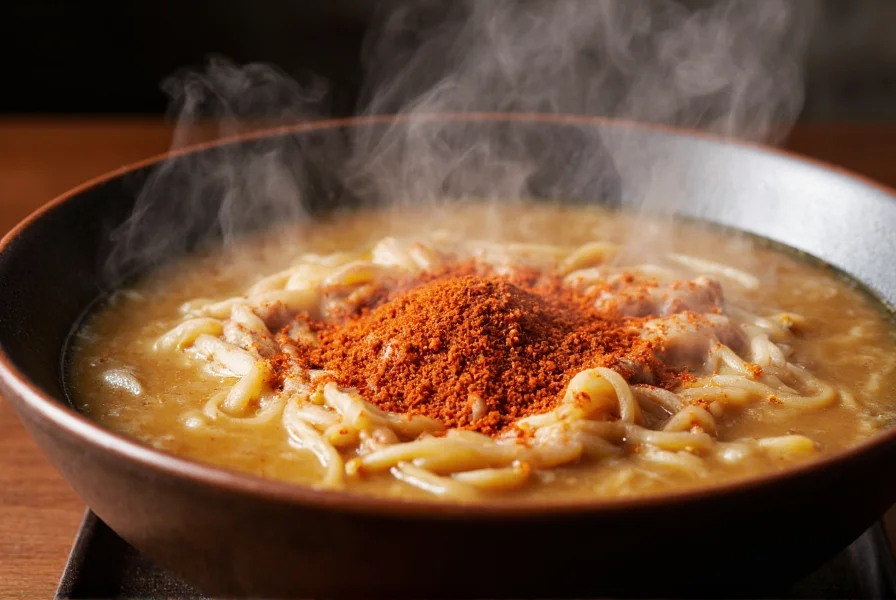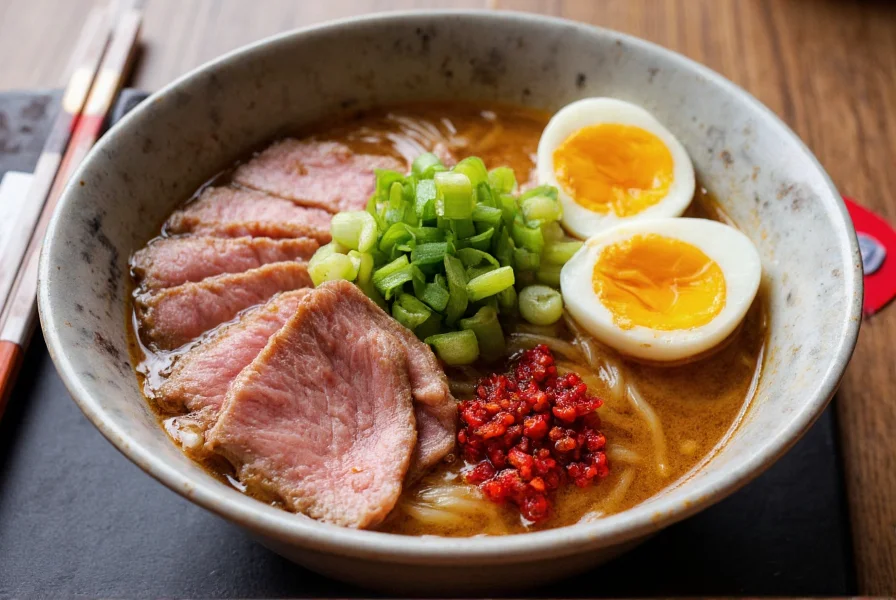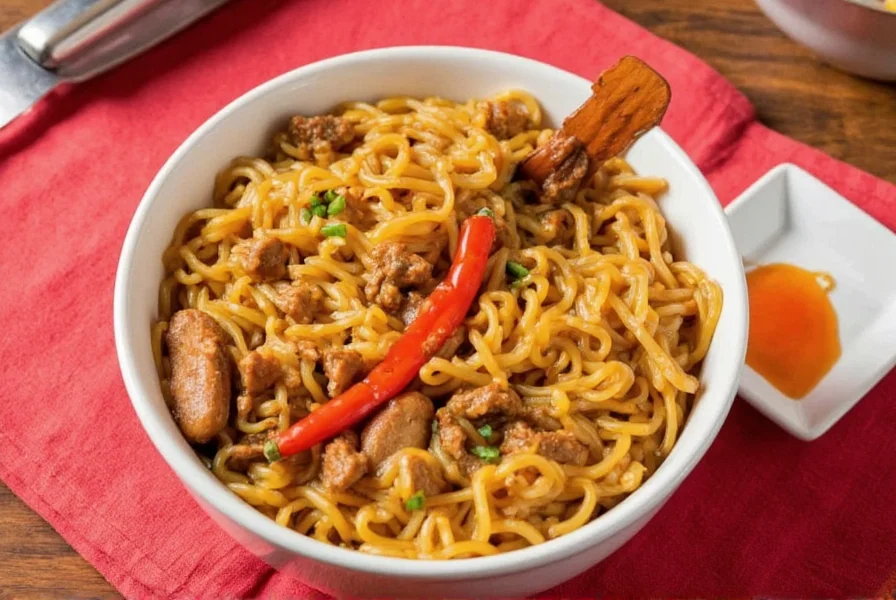Instant beef ramen already delivers satisfying savory notes, but adding red pepper transforms it from basic to restaurant-quality with minimal effort. This simple addition works because capsaicin in red pepper interacts with the glutamates in beef broth, creating a more complex flavor profile that satisfies multiple taste receptors simultaneously.
The Science Behind the Flavor Pairing
Beef ramen's foundation is umami-rich broth, while red pepper contributes both heat and subtle fruitiness. When combined, they create what food scientists call sensory-specific satiety—your taste buds experience less flavor fatigue because the heat from the pepper resets your palate between bites. This is why spicy beef ramen often feels more satisfying and less monotonous than standard versions.
Types of Red Pepper for Beef Ramen
Not all red peppers work equally well with instant beef ramen. Here's how common options compare:
| Type | Heat Level (Scoville) | Best For | Recommended Amount |
|---|---|---|---|
| Red pepper flakes | 15,000-30,000 | Classic spicy ramen | 1/4-1/2 tsp per pack |
| Cayenne powder | 30,000-50,000 | Intense heat lovers | 1/8-1/4 tsp per pack |
| Gochugaru (Korean) | 1,500-10,000 | Complex, smoky flavor | 1/2-1 tsp per pack |
| Crushed Aleppo | 10,000-15,000 | Subtle, fruity heat | 1/4-1/2 tsp per pack |

Optimal Timing for Adding Red Pepper
The moment you add red pepper dramatically affects the final flavor. For best results:
- Dry addition: Sprinkle flakes directly onto cooked noodles before adding broth for concentrated heat spots
- Broth infusion: Add powder to boiling water for evenly distributed warmth throughout the broth
- Finishing touch: Garnish with extra flakes after cooking for visual appeal and immediate heat impact
Food testing reveals that adding red pepper to the boiling water creates the most balanced flavor profile, as the heat extracts gradually during cooking. This method works particularly well with best spices for instant beef ramen that you want fully integrated.
Complementary Ingredients That Boost the Combination
Red pepper with beef ramen reaches its full potential when paired with these additions:
- Sesame oil: 1/2 teaspoon balances the heat with nutty richness
- Green onions: Fresh slices add brightness that cuts through spice
- Garlic: One minced clove enhances the savory depth
- Soy sauce: 1 teaspoon amplifies umami without saltiness
For those exploring how to spice up beef ramen with red pepper, try this professional chef technique: Bloom the red pepper flakes in hot oil for 30 seconds before adding broth. This releases essential oils that distribute flavor more evenly than adding directly to liquid.
Avoiding Common Red Pepper Mistakes
Many home cooks make these errors when enhancing instant ramen with spices:
- Over-spicing: Start with less than you think—you can always add more
- Wrong timing: Adding delicate peppers too early diminishes their flavor
- Ignoring regional variations: Korean gochugaru works differently than Italian flakes
- Skipping balancing elements: Acid (like lime) or fat (like egg yolk) prevents spice from dominating

Regional Variations Worth Trying
Different cultures have perfected red pepper and beef ramen combinations:
- Korean-style: Use gochugaru with garlic and sesame oil for authentic spicy beef ramen recipe modifications
- Mexican fusion: Add cayenne with lime juice and cilantro for unexpected flavor pairing for beef ramen
- Japanese-inspired: Light sprinkle of togarashi with nori for subtle heat that doesn't overpower
Understanding these cultural approaches helps you make informed decisions about instant ramen seasoning upgrades that suit your personal taste preferences. The key is respecting the base flavor of the beef broth while enhancing it thoughtfully.
Perfecting Your Spicy Ramen Technique
For optimal results when using red pepper with instant beef ramen, follow this sequence:
- Boil water with red pepper flakes or powder already added
- Cook noodles in the spiced water according to package directions
- Stir in seasoning packet and any additional spices
- Top with fresh garnishes like green onions and sesame seeds
- Serve immediately while broth is piping hot
This method ensures the red pepper's flavor fully integrates with the broth rather than sitting on top. For those wondering does cayenne pepper work with beef ramen specifically, the answer is yes—but use half the amount you would of milder red pepper flakes due to its higher heat level.
FAQ: Red Pepper and Beef Ramen
How much red pepper should I add to one pack of instant beef ramen?
Start with 1/4 teaspoon of red pepper flakes or 1/8 teaspoon of cayenne powder per pack. You can always add more after tasting, but you can't remove excess spice. The ideal amount depends on your heat tolerance and the specific ramen brand's saltiness.
Can I use fresh red peppers instead of dried in my beef ramen?
Yes, but with adjustments. Thinly slice fresh red peppers (like Fresno or Thai chilies) and add them during the last minute of cooking. Fresh peppers provide brighter, fruitier heat compared to the deeper, more concentrated flavor of dried options. Use about 1-2 teaspoons of finely chopped fresh pepper per serving.
Does red pepper work better with certain beef ramen brands?
Yes, richer beef broths like Shin Ramyun or Ottogi Jin Ramen handle red pepper better than lighter versions. The robust flavor base stands up to the heat without becoming unbalanced. For milder brands, reduce the red pepper amount by half to maintain flavor harmony.
What should I do if I've added too much red pepper to my ramen?
If your ramen becomes too spicy, add dairy (like a splash of milk or yogurt), acid (lime or lemon juice), or sweetness (a pinch of sugar) to counterbalance the heat. You can also dilute with additional broth or water. Adding a soft-boiled egg helps absorb excess spice while enhancing creaminess.
Can I combine red pepper with other spices for beef ramen?
Absolutely. Red pepper pairs exceptionally well with garlic powder, black pepper, and a touch of five-spice powder. For authentic Korean-style spicy beef ramen, combine red pepper flakes with gochujang (Korean chili paste). Avoid mixing multiple intense spices that might compete rather than complement each other.











 浙公网安备
33010002000092号
浙公网安备
33010002000092号 浙B2-20120091-4
浙B2-20120091-4